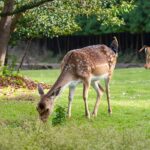Have you ever wondered where deer sleep? Understanding the resting habits of these majestic creatures can provide valuable insights into their behavior and help us appreciate their nocturnal lifestyle.
Deer, particularly white-tailed deer, are known for their crepuscular behavior, meaning they are most active during dawn and dusk. During the day, deer typically find a safe spot to rest and bed down, especially in heavily hunted areas. These resting places, known as deer beds, can be identified by their simple oval or kidney-bean shapes on the ground.
While resting, deer engage in a process called rumination, where they regurgitate previously consumed food and chew on it again. This allows them to extract maximum nutrition from their diet while getting the rest they need. It’s an amazing adaptation that ensures their survival in the wild.
When evening arrives, deer emerge from their resting places and make their way towards feeding areas. Tracking their movement patterns through signs like tracks, trails, scat, beds, rubs, scrapes, and browse can help us understand their behavior and even determine the size and gender of individual deer.
Overall, deer have fascinating sleeping habits that are closely tied to their survival and daily routines. Let’s delve deeper into the daily schedule of bucks during the rutting season and the unique sleep patterns of reindeer in the Arctic.
Content Highlights
ToggleKey Takeaways:
- Deer are crepuscular animals, most active at dawn and dusk.
- During the day, deer rest and bed down in safe spots, known as deer beds.
- Rumination is a vital process that allows deer to extract maximum nutrition while resting.
- Tracking deer movement patterns through various signs can provide valuable insights.
- Deer emerge in the evening to feed and continue their daily routines.
The Daily Routine of a Buck During the Rutting Season
During the rutting season, dominant bucks follow a specific daily routine, exhibiting interesting behaviors and rituals. Let’s take a closer look at their behavior during this intense period.
Buck Behavior in the Rut
When the buck rutting season begins, bucks often break away from the females they have bred and return to their bedding sanctuaries after dawn. This strategic move helps them rest and regain energy for the upcoming challenges of the day.
One of the key aspects of buck behavior during rut is their role as protectors. Bucks fiercely guard their does against rival bucks, especially younger ones, using various defensive techniques. These confrontations can result in scars and injuries, but the high levels of testosterone in their bloodstream reduce their pain sensations.
Mornings are essential for bucks to rest and listen to the sounds of the woods. After resting, bucks engage in short periods of rumination and browsing to sustain their energy levels. This combination of rest and feeding helps bucks maintain their physical condition during this demanding season.
Buck Mating Rituals
In the afternoon, bucks may change their bedding areas and engage in specific behaviors to establish their dominance and attract females for mating. Rubbing trees and creating scrapes are common rituals that bucks use to mark their territory and leave their scent for other deer to notice.

These rituals serve as visual and olfactory signals, allowing bucks to communicate their strength and readiness for breeding. The scraping of the ground and the deposition of scent from their interdigital glands play a vital role in buck communication during rut.
Despite their slow pace during this time, bucks remain alert and vigilant for any intruders or potential threats that may encroach upon their territory.
“During the rutting season, bucks follow a distinct daily routine, focusing on rest, protection, and attracting mates through territorial rituals.” – Wildlife Expert
To summarize, the daily routine of a buck during the rutting season involves resting in bedding sanctuaries, guarding does from rival bucks, engaging in short periods of rumination and browsing for sustenance, and performing mating rituals to attract females. This behavior demonstrates the unique strategies that bucks employ to ensure reproductive success during this critical time.
Reindeer's Unique Sleep Patterns in the Arctic
Reindeer in the Arctic exhibit fascinating sleep patterns that are influenced by the extreme environmental conditions they face. With constant darkness in winter and continuous daylight in summer, these polar animals have adapted to unique sleep behaviors to survive in their harsh habitat.
Unlike most animals that follow a consistent circadian rhythm, Arctic reindeer have the extraordinary ability to override their internal body clocks and distribute their sleep across the 24-hour day. While they primarily sleep during the night in the fall, their sleep patterns change during the winter and summer months.
Research indicates that reindeer’s sleep is spread throughout the day in the winter and summer, allowing them to rest whenever necessary and maintain their energy levels.
One of the remarkable aspects of reindeer’s sleep behavior is their ability to engage in rumination while resting. Rumination is a crucial process that helps reindeer extract nutrients from their food and aids in digestion. By multitasking and combining rest with rumination, reindeer can efficiently fuel their bodies while also providing necessary downtime.
Reindeer Sleep Patterns:
| Sleep Stage | Duration |
|---|---|
| Non-REM Sleep | Approximately 5 hours |
| REM Sleep | Approximately 1 hour |
| Rumination | Approximately 3 hours |
Regardless of the natural light pattern, reindeer allocate around five hours to non-REM sleep, one hour to REM sleep, and three hours to rumination each day. This unique sleep pattern ensures that reindeer can effectively conserve energy and cope with the demanding conditions in the Arctic.
Understanding the sleep patterns and behaviors of Arctic reindeer is crucial for conservation efforts and managing their natural habitat. As human activity continues to impact Arctic ecosystems, it becomes increasingly important to provide reindeer and other polar animals with the necessary time and space for sleep and rest.

Conclusion
Sleep is crucial for the well-being of animals, including deer and reindeer. It plays a vital role in maintaining their health and energy levels. Recognizing the importance of sleep in animals, especially in livestock, is essential for enhancing their productivity. Livestock industries should prioritize providing proper sleep hygiene to cows, sheep, and goats, as it can positively impact their overall well-being and productivity.
In addition to its effects on productivity, sleep also plays a significant role in conservation efforts. The amount of sleep an organism gets directly affects its energy levels, which are crucial for survival and the overall balance of ecosystems. Hence, it is important to consider the sleep needs of animals, such as reindeer, in environmental impact assessments.
In Arctic ecosystems, where human activity is increasing, allowing animals like reindeer sufficient time and space for rest and rumination is of utmost importance. As the constant darkness in winter and continuous daylight in summer disrupts their natural sleep patterns, understanding and respecting their sleep needs becomes crucial for their survival. By prioritizing the sleep needs of animals in the Arctic, we can contribute to maintaining the delicate balance of these unique ecosystems.
- California Deer Hunting Guide: Seasons, Rules, Permits, and More - 26 June 2024
- Arkansas Deer Season 2024 [Schedules, Licenses, Bag Limits & More!] - 26 June 2024
- 2024 Arizona Deer Season New Dates & Rules! - 25 June 2024




